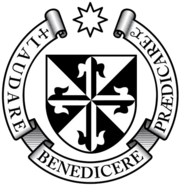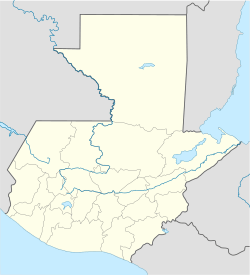Sacapulas facts for kids
Quick facts for kids
Sacapulas
|
|
|---|---|
|
Municipality
|
|

The Municipal building in Sacapulas
|
|
| Country | |
| Department | |
| Municipality | Sacapulas |
| Government | |
| • Type | Municipal |
| Area | |
| • Municipality | 114 sq mi (294 km2) |
| Elevation | 3,900 ft (1,200 m) |
| Population
(Census 2018)
|
|
| • Municipality | 52,620 |
| • Density | 463.6/sq mi (179.0/km2) |
| • Urban | 12,225 |
| • Ethnicities | Sakapultek K'iche' Ladino |
| • Religions | Roman Catholicism Evangelicalism Maya |
| Climate | Am |
Sacapulas is a town and municipality in the Guatemalan department of El Quiché. It is a place with a rich history and a unique culture.
History
Ancient Times
Long ago, a K'iche' king was worried about a family called aj K’ub’ul. They had left his land to find a peaceful place to live. The king sent soldiers to watch them. He feared the aj K'ub'ul might team up with other groups and attack him.
The soldiers saw that the aj K’ub’ul were very peaceful. They worked their land and enjoyed their families. They did not want to fight. The soldiers told the king not to worry. Over time, the soldiers liked the peaceful life of the aj K’ub’ul. They went back to their home, Tujalj (which included Sacapulas). They brought their families and settled near where they had watched the aj K’ub’ul.
Spanish Conquest in the Mountains
After the Spanish took over Zaculeu, they explored the Sierra de los Cuchumatanes mountains. They hoped to find gold and silver. But the mountains were remote and hard to travel through. This made them difficult to conquer. Many native people in the Cuchumatanes became sick from European diseases. Their population dropped a lot before the Spanish even arrived.
Battles with the Ixil and Uspantek
The Ixil and Uspantek Maya lived in a secluded part of the Cuchumatanes. They were allies and resisted the Spanish. In 1529, Uspantek warriors caused trouble for the Spanish. They also tried to start a rebellion among the K'iche' people.
The Spanish decided to send an army. Gaspar Arias led sixty Spanish soldiers and three hundred native allies. He took control of the Ixil towns of Chajul and Nebaj. Then, he marched towards Uspantán. But Arias was called back, and Pedro de Olmos took command. Olmos attacked Uspantán directly. More than two thousand Uspantek warriors ambushed the Spanish. The Spanish army lost many soldiers. Many native allies were captured. The survivors went back to Q'umarkaj.
A year later, Francisco de Castellanos led another expedition. He had Spanish cavalry, infantry, and many native allies. They marched to Sacapulas and climbed the mountains. They fought a large force of Ixil warriors from Nebaj. After a long battle, the Spanish won. They captured the city and set it on fire. Many Ixil defenders were enslaved as punishment.
The people of Chajul surrendered when they heard the news. The Spanish continued to Uspantán. Ten thousand warriors defended it, including forces from Sacapulas. The Spanish were outnumbered but won the battle with their cavalry and firearms. They took Uspantán and enslaved the surviving warriors. By December 1530, the military conquest of the Cuchumatanes was complete.
Peaceful Conversion by Dominican Friars
In 1537, a friar named Bartolomé de las Casas wanted to try a new way to convert native people. He believed in treating everyone equally. He also thought conversion should be voluntary. He chose a difficult area in Guatemala that had not been conquered by force. The governor agreed not to set up new settlements if Las Casas succeeded.
Las Casas and his friars started a Dominican presence in Rabinal, Sacapulas, and Cobán. They reached as far as Chahal. This area, once called the "Land of War," became "Verapaz" or "True Peace." Las Casas's plan was to teach Christian songs to native merchants. These merchants then shared the songs in the area. This helped convert several native chiefs. Churches were built in Alta Verapaz. In 1538, Las Casas left to find more friars for his mission.
Monasteries and Doctrines of the Order of Preachers

After the conquest, the Spanish crown wanted to teach Catholicism to the native people. New settlements founded by missionaries were called "Indian doctrines." Friars were supposed to teach the Catholic faith and Spanish. Then, these settlements would become regular parishes.
However, this plan did not fully happen. The friars had special rights to convert natives. They answered only to their own religious leaders, not to the Spanish government. Once a doctrine was set up, the friars protected their own interests. The doctrines became native towns that stayed the same for a long time.
These doctrines were run by groups of friars. This made sure the community system continued even if one friar died. In 1638, the Order of Preachers divided their large doctrines. Sacapulas had its own monastery and doctrine.
| Convent | Doctrines | Convent | Doctrines |
|---|---|---|---|
| Guatemala |
|
Amatitlán | |
| Verapaz | |||
| Sonsonate |
|
||
| San Salvador |
|
Sacapulas |
|
In 1754, the Order of Preachers had to give up their doctrines and convents. This was part of changes made by the Spanish crown.
After Central American Independence
After Central America became independent in 1821, a civil war began. It was between conservatives and liberals. Conservatives wanted to keep the old religious orders in power. Liberals wanted to remove them. In 1829, the liberal general Francisco Morazán won. The conservative government was overthrown. Religious orders were expelled from Central America. This greatly affected Sacapulas. The Order of Preachers had to leave their doctrines and monastery.
When conservatives regained power in 1840, religious orders returned to Guatemala. But they could not get back their old properties. They were expelled again after the Liberal Revolution of 1871. In 1872, the Quiché Department was created. Sacapulas then became a municipality.
Guatemalan Civil War
During the Guatemalan Civil War, Sacapulas was in an area where a group called the Ejército Guerrillero de los Pobres (EGP) was active. This group sometimes damaged public buildings and infrastructure. They said this was to weaken the army. They also aimed to create chaos. For example, they would cut power to army barracks. This also affected nearby towns and villages.
Some EGP actions that affected the region around Sacapulas included:
| Date | Target | Result |
|---|---|---|
| 16 November 1981 | State Power Institute facilities in Santa Cruz del Quiché | Left nearby towns without power. |
| 18 December 1981 | «El Tesoro» Bridge in Quiché Department | The bridge was destroyed, blocking army access. |
| 21 December 1981 | Cunén's town hall and telegraph facilities | Buildings were set on fire to destroy records. |
| 19 January 1982 | State Power Institute facilities in Santa Cruz del Quiché | Left nearby towns without power. |
| 27 January 1982 | Bridges to San Miguel Uspantán, Nebaj and Chajul in Quiché Department | Bridges were destroyed, blocking army access. |
To fight back, the government launched a strong campaign. This included attacks on civilian communities. These events led to many hardships for the people. Reports from the time describe massacres and bombings. Sacapulas and the Ixil triangle were heavily affected. After these attacks, many people left their homes. They went into the mountains, to Mexico, or to other communities. Those who stayed in the mountains were often seen as "guerrillas" by the army. This made it very hard for them to get food or medical help. Many people died from hunger.
Specific incidents recorded in Sacapulas during this time include:
| Date | Location |
|---|---|
| April 1980 | Parraxtut village |
| April 1980 | Río Blanco village |
| September 1981 | Tzununul village |
| December 1981 | Guantajau village |
| February 1982 | Tierra Colorada village |
| March 1982 | Parraxtut village |
| March 1982 | Tierra Caliente village |
| March 1982 | Sacapulas villa |
| May 1982 | Guantajau village |
| May 1982 | Sacapulas villa |
| August 1982 | Río Blanco village |
| April 1983 | Salinas Magdalena village |
Sacapulas in the 21st Century
In 2006, a new paved road connected Sacapulas to Aguacatán and Nebaj. This road has helped the area by providing better access to markets. It also brings new chances for economic growth and development.
Archeological Site
Xutixtiox (also known as Chutix Tiox or Chotaxtiox) is an important archeological site. It is located in Sacapulas.
Climate
Sacapulas has a tropical savanna climate. This means it has warm temperatures all year. It also has distinct wet and dry seasons.
| Climate data for Sacapulas (1991–2020) | |||||||||||||
|---|---|---|---|---|---|---|---|---|---|---|---|---|---|
| Month | Jan | Feb | Mar | Apr | May | Jun | Jul | Aug | Sep | Oct | Nov | Dec | Year |
| Record high °C (°F) | 37.0 (98.6) |
38.0 (100.4) |
41.0 (105.8) |
39.0 (102.2) |
38.5 (101.3) |
37.0 (98.6) |
35.0 (95.0) |
35.6 (96.1) |
35.5 (95.9) |
36.0 (96.8) |
35.5 (95.9) |
35.0 (95.0) |
41.0 (105.8) |
| Mean daily maximum °C (°F) | 29.1 (84.4) |
30.6 (87.1) |
32.2 (90.0) |
33.4 (92.1) |
32.3 (90.1) |
30.3 (86.5) |
29.9 (85.8) |
30.6 (87.1) |
30.2 (86.4) |
29.3 (84.7) |
28.6 (83.5) |
28.6 (83.5) |
30.4 (86.7) |
| Daily mean °C (°F) | 20.5 (68.9) |
21.7 (71.1) |
22.9 (73.2) |
24.3 (75.7) |
24.2 (75.6) |
23.1 (73.6) |
22.7 (72.9) |
23.1 (73.6) |
22.8 (73.0) |
22.1 (71.8) |
21.1 (70.0) |
20.5 (68.9) |
22.4 (72.3) |
| Mean daily minimum °C (°F) | 13.2 (55.8) |
13.7 (56.7) |
14.7 (58.5) |
16.3 (61.3) |
17.5 (63.5) |
17.6 (63.7) |
16.9 (62.4) |
17.0 (62.6) |
17.5 (63.5) |
16.8 (62.2) |
14.9 (58.8) |
13.6 (56.5) |
15.8 (60.4) |
| Record low °C (°F) | 1.3 (34.3) |
3.3 (37.9) |
3.3 (37.9) |
9.2 (48.6) |
10.0 (50.0) |
4.5 (40.1) |
12.8 (55.0) |
10.4 (50.7) |
13.1 (55.6) |
10.4 (50.7) |
4.8 (40.6) |
3.7 (38.7) |
1.3 (34.3) |
| Average precipitation mm (inches) | 2.2 (0.09) |
1.0 (0.04) |
10.3 (0.41) |
35.7 (1.41) |
87.0 (3.43) |
187.0 (7.36) |
95.9 (3.78) |
120.6 (4.75) |
180.0 (7.09) |
105.3 (4.15) |
29.4 (1.16) |
6.1 (0.24) |
860.5 (33.88) |
| Average precipitation days (≥ 1.0 mm) | 0.7 | 0.3 | 1.5 | 3.8 | 6.7 | 14.5 | 10.4 | 10.7 | 14.9 | 9.7 | 3.2 | 0.9 | 77.3 |
| Source: NOAA | |||||||||||||
Geographic Location
Sacapulas is mostly surrounded by other municipalities in the El Quiché region.
 |
Nebaj and Cunén | Cunén |  |
|
| Totonicapán Department San Pedro Jocopilas, El Quiché municipality |
San Andrés Sajcabajá | |||
| San Pedro Jocopilas | San Pedro Jocopilas and San Bartolomé Jocotenango |
Images for kids
See also
 In Spanish: Sacapulas para niños
In Spanish: Sacapulas para niños




